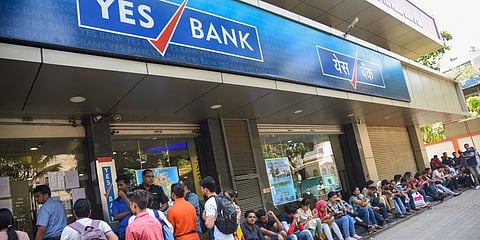

“We will not allow any institution to fall off the cliff”. That was Finance Minister Nirmala Sitharaman assuring masses and markets on Friday, shortly after private sector Yes Bank joined the parade of financial institutions crumbling into a heap.
The assurance is doubtless touching and powerful, but the credibility of the assurance itself depends not on words but on past actions. The Finance Minister may want to run a check with officials in her ministry and the regulator Reserve Bank of India on the status of previous collapses. For instance, of Infrastructure Leasing and Financial Services (IL&FS) in the fall season of 2018, of Dewan Housing Finance Corporation in the summer of 2019, and most recently small savers institution Punjab and Maharashtra Cooperative Bank.
The script of each of the institutions follows a familiar storyline — of hype, hubris, flawed financial models. Fragility, Nassim Nicholas Taleb says, is the quality of things that are vulnerable to volatility. And vulnerability in the financial sector is defined by diligence and disclosure levels. Typically the collapse of the institution is preceded by graft and siphoning, followed by cases of money laundering filed by the ED.
The collapse of IL&FS, an event this column described as India’s Lehman Moment, was triggered by a two-line letter issued by IL&FS to the BSE expressing its failure to honour a Letter of Credit issued by IDBI Bank. Nearly 18 months after the collapse of IL&FS, the fate of creditors, banks and mutual funds and depositors and the monies is in the domain of what Donald Rumsfeld would define as known unknown!
DHFL went down in September 2019 — its decimation was not entirely unconnected to the collapse of IL&FS. Like the IL&FS, housing finance outfit DHFL was felled by hubris and horrific management. As with the controversial and hyper visible IL&FS, DHFL was a marquee player in the financial markets. In March 2020, neither the creditors of DHFL nor the depositors with nearly Rs 5,000 crore stuck in the outfit have got their money back.
The PMC Bank, which once again was connected to another crumbling edifice called DHFL, tottered at the brink of a run and complete collapse following the discovery of unexplainable holes in its balance sheet — stemming from lending to borrowers, 73 per cent to one borrower, apparently on the basis of assurances of promoters with dubious political connections. Notwithstanding loss of life and agitations, the savers, living across six states, are yet to find closure to their grief.
Yes Bank is no different from that of the examples cited. It was set up by a hyper-ambitious Rana Kapoor in 2004 and had set itself the goal of ‘Building the Best Quality Bank of the world in India’ by 2015. Kapoor propelled the expansion of Yes Bank even as many in Mumbai would ask in typical Bombay lingo ‘boss what’s the magic here’. In 2018, the first glimpse of the Yes Bank magic and the signs of fragility came to the fore when it was discovered its lending growth was nearly twice its deposit growth. At risk: depositors’ monies, and that of Lord Jagannath at Puri, adding up to over Rs 2.1 lakh crore.
It is good to know that the finance ministry will not allow any institution to fall off the cliff — and honourably it had no other option given the systemic risk the bank represents. Indeed, the staged rescue of India’s fourth largest private sector bank by public sector owned SBI is essentially nationalisation of costs by another name. But the persistence of failures begs a question, the finance minister must ask, of her mandarins and the RBI, as to how these institutions land up on the brink of the cliff.
There is at the corporate level poor governance — the boards of the institutions were steeped in sloth, the auditors flailed and failed in diligence, the actions of rating agencies have been post mortem. There is also the spectre of regulatory pusillanimity.The RBI, for instance, was aware of chinks in the IL&FS model in 2014–15 but did nothing. It knew of the tango of NBFCs and mutual funds, of promoters and banks. It got Kapoor off the board of Yes Bank, but then allowed a fishing expedition for new investors even as conditions worsened.
The series of collapses is reminiscent of the Sherlock Holmes story about the curious case of the dog that did not bark. The regulators curiously did not know or probe what the markets knew and were reacting to. This column had mentioned how a housing finance unit, an NBFC and a private sector bank were enveloped in rumours and had underlined the cohabitation of Cabals and Credit Contagion.
At the crux is the lack of capacity in the regulatory realm and within the finance ministry to assess, analyse, imagine scenarios and engineer instruments for preclusion and resolution. Financial markets and institutions are like circuits wired in serial — if one bulb burns out, the entire circuit is rendered fragile. A $ 2.8 trillion economy cannot afford the luxury of parade of collapses in the most critical segment of the economy.
Failure is embedded in market economics. The debate is not about what cannot be prevented but about what could have been done but was not done.